 [Image: The “renovation of an old barn into a library and studio” by MOS architects].
[Image: The “renovation of an old barn into a library and studio” by MOS architects].
BLDGBLOG’s home office here is awash in books. Accordingly, I’ve started a new and more or less regular series of posts called “Books Received.” These will be short descriptions of, and links to, interesting – but not necessarily new – books that have crossed my desk.
Note that these lists will include books I have not read in full – but they will never include books that don’t deserve the attention.
Note, as well, that if you have a book you’d like to see on BLDGBLOG, get in touch – send us a copy, and, if it fits the site, we’ll mention your title in a future Books Received.
Note, finally, that even this list is barely the tip of the iceberg; if you’ve sent me a book recently, please wait till the next list before wondering if I’ll be covering your work. Thanks!
 1) The Antarctic: From the Circle to the Pole by Stuart D. Klipper et al. (Chronicle Books) — Horizontally oriented – that is, you read it like a centerfold – The Antarctic is a genuinely beautiful collection of panoramic photographs taken of, on, and approaching the ice-locked continent. From clouds to empty stretches of black sea water to glacial abstractions – to penguins – Stuart Klipper’s work is a superb document of this frozen landscape. It’s 0º in widescreen. Includes a notable essay by William L. Fox.
1) The Antarctic: From the Circle to the Pole by Stuart D. Klipper et al. (Chronicle Books) — Horizontally oriented – that is, you read it like a centerfold – The Antarctic is a genuinely beautiful collection of panoramic photographs taken of, on, and approaching the ice-locked continent. From clouds to empty stretches of black sea water to glacial abstractions – to penguins – Stuart Klipper’s work is a superb document of this frozen landscape. It’s 0º in widescreen. Includes a notable essay by William L. Fox.
 2) Wildwood: A Journey Through Trees by Roger Deakin (Penguin) — The UK paperback edition has a wonderfully textured feel, as if the cover was printed on watercolor paper; that the paper itself, sourced from Forest Stewardship trees, has a distinct materiality to it, fits this book perfectly. The late Roger Deakin travels through the forests of Eurasia and Australia, from the willows of Cambridgeshire, past ruined churches in the Bieszczady Woods, to the towering walnut groves of Kazakhstan. The book had me hooked from page one, where Deakin writes that “the rise and fall of the sap that proclaims the seasons is nothing less than a tide, and no less influenced by the moon.” Deakin was an amazing writer. At one point he describes “the iceberg depths of the wood’s root-world,” just one mind-bending moment in a book so full of interesting sub-stories that I could post about it all month. Don’t miss the Deer Removal Act of 1851, the surreal Jaguar Lount Wood (a landscape sponsored by the automotive firm), the chainsaw-resistant oaks of the Bialowieza Forest – their trunks sparkling with shrapnel from WWII – and the unforgettable closing chapters about harvesting apples and walnuts in the giant forests of Kazakhstan and Kyrgyzstan.
2) Wildwood: A Journey Through Trees by Roger Deakin (Penguin) — The UK paperback edition has a wonderfully textured feel, as if the cover was printed on watercolor paper; that the paper itself, sourced from Forest Stewardship trees, has a distinct materiality to it, fits this book perfectly. The late Roger Deakin travels through the forests of Eurasia and Australia, from the willows of Cambridgeshire, past ruined churches in the Bieszczady Woods, to the towering walnut groves of Kazakhstan. The book had me hooked from page one, where Deakin writes that “the rise and fall of the sap that proclaims the seasons is nothing less than a tide, and no less influenced by the moon.” Deakin was an amazing writer. At one point he describes “the iceberg depths of the wood’s root-world,” just one mind-bending moment in a book so full of interesting sub-stories that I could post about it all month. Don’t miss the Deer Removal Act of 1851, the surreal Jaguar Lount Wood (a landscape sponsored by the automotive firm), the chainsaw-resistant oaks of the Bialowieza Forest – their trunks sparkling with shrapnel from WWII – and the unforgettable closing chapters about harvesting apples and walnuts in the giant forests of Kazakhstan and Kyrgyzstan.
3) The Wild Places by Robert Macfarlane (Penguin) — Robert Macfarlane was close friends with Roger Deakin, and Deakin’s presence is often cited throughout The Wild Places. Macfarlane’s frustratingly good book focuses on the natural landscapes of Britain, describing the author’s quest for sites of true wildness in today’s UK. Macfarlane is also a fantastic writer; this is another book that could easily be unspun into a whole month’s worth of blog posts. As but one example, Macfarlane finds himself exploring holloways, those deeply incised, sunken roads produced over decades by the passage of people, carts, and horses. Each holloway is “a route that centuries of use has eroded down into the bedrock,” Macfarlane explains, “so that it is recessed beneath the level of the surrounding landscape.” He continues, writing that “the holloways have come to constitute a sunken labyrinth of wildness in the heart of arable England. Most have thrown up their own defences, becoming so overgrown by nettles and briars that they are unwalkable, and have gone unexplored for decades.”
4) Dry Storeroom No. 1: The Secret Life of the Natural History Museum by Richard Fortey (Knopf) — Richard Fortey is one of my favorite authors; his Earth: An Intimate History should be required reading for anyone with even a passing interest in the planetary sciences. Here, Fortey takes us behind the scenes at the institution from which he has only recently retired: London’s Natural History Museum. His descriptions of the museum itself are worth quoting at length. “There seemed to be no end to it,” he writes, referring to the building’s sprawling rooms and corridors:
Even now, after more than thirty years of exploration, there are corners I have never visited. It was a place like Mervyn Peake’s rambling palace of Gormenghast, labyrinthine and almost endless, where some forgotten specialist might be secreted in a room so hard to find that his very existence might be called into question. I felt that somebody might go quietly mad in a distant compartment and never be called to account. I was to discover that this was no less than the truth.
Further:
Even to find one’s ways to the towers is an exercise in map reading. The visitor has to go through one door after another apparently leading nowhere. Then there are thin flights of steep stairs that go upwards from floor to floor; I am reminded of a medieval keep, where one floor was for feasting and the next one for brewing up boiling oil. I discovered part of one tower that could only be accessed by a ladder stretched over a roof. Nowadays, the towers do not have permanent staff housed there – something to do with them lacking fire escapes and not complying with some detail of the Health and Safety at Work Act of 1974. Instead there are empty rooms, or ones holding stacks of neglected stuff. A hermit could hide here, undiscovered.
As a way to slip behind the Staff Only doors at a major world museum, the book is unsurpassed.
5) Victory Gardens 2007+ by Amy Franceschini (Gallery 16 Editions) — For the most part, a photo-documentation of the “victory gardens” of Amy Franceschini, scattered amongst the various microclimates of San Francisco, this hardcover guide to urban gardening will make almost anyone want to go out and plant rows of buttercrunch lettuce. Locavores, guerilla gardeners, and revolutionary horticulturalists take note.
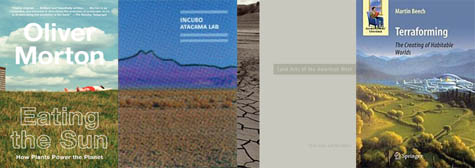 6) Eating the Sun: How Plants Power the Planet (Harper) — Of course, all these trees and gardens require sunlight – and the chemically transformative inner workings of photosynthesis are the subject of Oliver Morton’s newest book, Eating the Sun. Morton, a Features Editor at Nature, is also the author of the excellent Mapping Mars: Science, Imagination, and the Birth of a World.
6) Eating the Sun: How Plants Power the Planet (Harper) — Of course, all these trees and gardens require sunlight – and the chemically transformative inner workings of photosynthesis are the subject of Oliver Morton’s newest book, Eating the Sun. Morton, a Features Editor at Nature, is also the author of the excellent Mapping Mars: Science, Imagination, and the Birth of a World.
7) Atacama Lab by Chris Taylor et al. (Incubo) and Land Arts of the American West by Chris Taylor and Bill Gilbert (University of Texas Press) — Two awesome books of landscape design, history, art, and theory, both involving the formidable talents of Chris Taylor. According to Taylor’s own introduction, Atacama Lab – which is bilingually printed in both Spanish and English, contrary to Amazon’s indications – documents “the interpretive frame and working methods of Land Arts of the American West in Chile to broaden our understanding of earthworks and open a dialog between arid lands along the north-south axis of the Americas. The book includes a wide variety of student landscape projects, as well as an essay by the ubiquitous William L. Fox. If you’re wondering what exactly Land Arts of the American West is, you’re in luck: this massive, textbook-like, quasi-monographic guide to the eponymous research institute is an explosive catalog of the terrestrial work of Bill Gilbert, the group’s founder, here in collaboration with Taylor. They write:
Land Arts of the American West is a field program designed to explore the large array of human responses to a specific landscape over an extended period of time… Moving between the land and studio, our inquiry extends from the geologic forces that shape the ground itself to the cultural actions that define place. Within this context, land art includes everything from pictographs and petroglyphs to the construction of roads, dwellings, and monuments as well as traces of those actions.
It’s immersive landscape theory, armed with duffel bags and tents. Sign me up.
8) Terraforming: The Creating of Habitable Worlds by Martin Beech (Springer) — Hampered only an appalling choice of paper and by its factory-preset graphic design, Martin Beech’s Terraforming is otherwise a refreshingly quantitative approach to how whole planets can be made habitable for human beings. “The ultimate aim of terraforming,” Beech writes, “is to alter a hostile planetary environment into one that is Earth-like, and eventually walk upon the surface of the new and vibrant world that you or I could walk freely about and explore.” Usually the realm of science fiction and/or moral speculation – indeed, even this book opens with a fictional scenario set in the year 2100 – the controversial idea of terraforming here takes on a numeric, chemical, and even topographic specificity.
 9) Xenophon’s Retreat: Greece, Persia, and the End of the Golden Age (Harvard University Press) — Having been oddly obsessed with Xenophon’s Persian Expedition ever since learning that it was one of the inspirations for Sol Yurick’s novel The Warriors – check out BLDGBLOG’s interview with Yurick for more – I was excited to find Robin Waterfield’s micro-history of “Xenophon’s retreat.” The basic question: what do you do when you’re a highly trained mercenary fighting on the losing side in an unparalleled example of fratricidal desert warfare, and you now have to fight your way back home, on foot, temporarily living in caves, engaging in numerous minor skirmishes, followed by spies, passing from what would now be the suburbs of Baghdad to the western shores of Turkey? That’s exactly what Xenophon did – and he went on to a distinguished career as a writer and historian. In other words, it’s an absolutely incredible story. Waterfield’s descriptions of the physical reality of phalanx-based warfare are also awesomely intense.
9) Xenophon’s Retreat: Greece, Persia, and the End of the Golden Age (Harvard University Press) — Having been oddly obsessed with Xenophon’s Persian Expedition ever since learning that it was one of the inspirations for Sol Yurick’s novel The Warriors – check out BLDGBLOG’s interview with Yurick for more – I was excited to find Robin Waterfield’s micro-history of “Xenophon’s retreat.” The basic question: what do you do when you’re a highly trained mercenary fighting on the losing side in an unparalleled example of fratricidal desert warfare, and you now have to fight your way back home, on foot, temporarily living in caves, engaging in numerous minor skirmishes, followed by spies, passing from what would now be the suburbs of Baghdad to the western shores of Turkey? That’s exactly what Xenophon did – and he went on to a distinguished career as a writer and historian. In other words, it’s an absolutely incredible story. Waterfield’s descriptions of the physical reality of phalanx-based warfare are also awesomely intense.
10) After the City, This (Is How We Live) by Tom Marble (LA Forum) — At some point, architect Tom Marble had the ingenious idea of writing a book about the mysterious subcultures of real estate development and zoning in greater Los Angeles – but to write it as a screenplay. The results are both charming and readable. At times perhaps a bit too didactic to be put on screen by Steven Spielberg, as an experiment in mixing genres this is altogether brilliant, full of voice-over narratives and cuts from scene to scene and even color photographs. But to write this as a screenplay… I’m jealous.
EXT. REUNION — NIGHT
Nat walks up to the front door of a large Colonial house in Pasadena. He is about to knock when the door swings open, revealing a crowd of about twenty people.
Or:
EXT. SOFT ROCK CAFE — DAY
Nat and Jack sit at a restaurant table overlooking a koi pond. Consumer Jazz rises out of rock-shaped speakers. Nat can’t help notice beautiful twenty-something mothers swarm the bridges and banks of the pond, chatting with one another or chasing their kids.
As Nat bites into his sandwich, Jack smiles.
This is what I imagine might happen if Brand Avenue were to move to Hollywood and get a film deal. Again, genius.
11) Subterranean Twin Cities by Greg Brick (University of Minnesota Press) — I associate the underworlds of Minneapolis–St. Paul almost entirely with “Rinker’s Revenge,” an ailment peculiar to urban explorers mentioned by Michael Cook in his interview with BLDGBLOG. Rinker’s Revenge also makes an appearance in Greg Brick’s book-length journey through the city’s substructures, passing waterfalls, tunnels, wine cellars, and drains. “Let’s take an imaginary journey downward through the geological layers of Minnesota by way of a sewer,” Brick begins – before donning waterproof boots and making the descent himself.
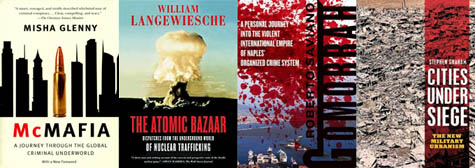 12) McMafia: A Journey Through the Global Criminal Underworld by Misha Glenny (Vintage) — A different kind of underworld comes to us in this book that I found absolutely impossible to put down. Wildly undersold by reviews on Amazon, I can’t recommend this book enough. A look at the global counter-economies of sex trafficking, drugs, illegitimate construction, counterfeit goods, and light weaponry, the otherwise somewhat embarrassingly titled McMafia shows us a planet riddled with labyrinthine networks of unregistered transactions, untraceable people, and even illegal building sites. Author Misha Glenny also has a wonderfully sober take on the U.S. War on Drugs, suggesting that is the War on Drugs itself that has allowed the hyper-explosive growth of narcotic black markets – which, in turn, fund wars, rape, violence, and kidnapping across dozens of other economic sectors, worldwide. Toward the end of the book, Glenny even implies that, if the U.S. were to change its approach to drugs, the knock-on effects would be instantly catastrophic for organized crime everywhere. Ignore the title; this is one of the most interesting books I’ve read all year.
12) McMafia: A Journey Through the Global Criminal Underworld by Misha Glenny (Vintage) — A different kind of underworld comes to us in this book that I found absolutely impossible to put down. Wildly undersold by reviews on Amazon, I can’t recommend this book enough. A look at the global counter-economies of sex trafficking, drugs, illegitimate construction, counterfeit goods, and light weaponry, the otherwise somewhat embarrassingly titled McMafia shows us a planet riddled with labyrinthine networks of unregistered transactions, untraceable people, and even illegal building sites. Author Misha Glenny also has a wonderfully sober take on the U.S. War on Drugs, suggesting that is the War on Drugs itself that has allowed the hyper-explosive growth of narcotic black markets – which, in turn, fund wars, rape, violence, and kidnapping across dozens of other economic sectors, worldwide. Toward the end of the book, Glenny even implies that, if the U.S. were to change its approach to drugs, the knock-on effects would be instantly catastrophic for organized crime everywhere. Ignore the title; this is one of the most interesting books I’ve read all year.
13) The Atomic Bazaar: Dispatches from the Underground World of Nuclear Trafficking by William Langewiesche (Farrar, Straus and Giroux) — Continuing this Final Four of crime, war, and violence, William Langewiesche’s The Atomic Bazaar could be described as a very long Atlantic article about the growing threat of nuclear trafficking. In the U.S. paperback copy, pages 6-10 are a seering, microsecond-by-microsecond description of what actually happens when a nuclear bomb explodes in a city; if nothing else, go to your local bookstore and read those pages. The rest of the book, however, present a fascinating look at the nightmarish world of post-Soviet nuclear arms storage facilities (and what Langewiesche suggests are the strategically self-defeating U.S. efforts to fund their protection), and an over-long (but fascinating) introduction to the life of A.Q. Khan, the Dutch-trained metallurgist who went on to give Pakistan its first nuclear bomb (and subsequently to market those nuclear secrets to North Korea, Iran, Iraq, and beyond).
14) Gomorrah: A Personal Journey into the Violent International Empire of Naples’ Organized Crime System by Roberto Saviano (Picador) — The perfect accompaniment to Misha Glenn’s McMafia, Gomorrah by Roberto Saviano – the writing of which resulted in the author having to disappear into police protection – is an often horrific look at the counter-state of organized private crime in and around Naples, Italy. Stomach-turning descriptions of torture – including a spiked baseball bat and decapitation by metal grinder – punctuate what is otherwise a remarkably thoughtful guide to the administrative reality of urban gangsterism. This is what happens to cities when a) there is no state and b) there are lots of machine guns. I hope to post about this book – now also a film – in more detail later, so I will leave my description at that. Suffice it to say, though, it’s worth the read.
15) Cities Under Siege: The New Military Urbanism by Stephen Graham (Verso) — Stephen Graham’s Cities Under Siege has not even been released yet, so I don’t know if it’s good – but I can’t wait to read it. “Drawing on a wealth of original research,” the publishers write, “Stephen Graham shows how Western and Israeli militaries and security forces now perceive all urban terrain as a real or imagined conflict zone inhabited by lurking, shadow enemies, and urban inhabitants as targets that need to be continually tracked, scanned, controlled and targeted.” Release date in July 2009.
* * *
All
Books Received:
August 2015,
September 2013,
December 2012,
June 2012,
December 2010 (“Climate Futures List”),
May 2010,
May 2009, and
March 2009.
 [Image: The Berlin Reich Chancellery, designed by Albert Speer].
[Image: The Berlin Reich Chancellery, designed by Albert Speer]. [Image: Hitler’s office in the Chancellery].
[Image: Hitler’s office in the Chancellery]. [Image: From
[Image: From 
 [Images: (top)
[Images: (top)  [Image: From
[Image: From  [Image: From
[Image: From  [Image: Channeling Ayn Rand, Andrew Ryan’s city banner announces “No Gods or Kings. Only Man.” From
[Image: Channeling Ayn Rand, Andrew Ryan’s city banner announces “No Gods or Kings. Only Man.” From  [Image: From
[Image: From  [Image: The “
[Image: The “ 1)
1)  2)
2)  6)
6)  9)
9)  12)
12)  [Image: The subterranean vaults of Manhattan, seen here in
[Image: The subterranean vaults of Manhattan, seen here in 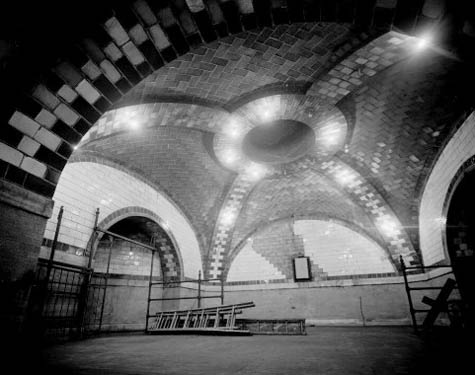 [Image: The great Manhattan underdome, photo by
[Image: The great Manhattan underdome, photo by  [Image: Photo by Jonathan Brown. Brown reviewed the launch on his blog,
[Image: Photo by Jonathan Brown. Brown reviewed the launch on his blog,  [Image: Antony Gormley’s Blind Light, 2007, courtesy of the artist and Jay Jopling/
[Image: Antony Gormley’s Blind Light, 2007, courtesy of the artist and Jay Jopling/ [Image:
[Image:  [Image: A dream of freeways above the city, at
[Image: A dream of freeways above the city, at  [Image: Bookstore for Shibuya Publishing, Japan, designed by
[Image: Bookstore for Shibuya Publishing, Japan, designed by  1)
1) 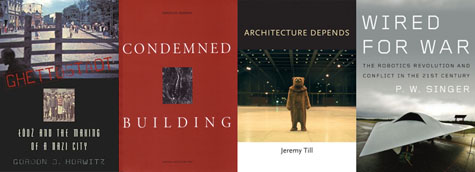 4)
4)  8)
8)  If you could design a bridge across the Bering Strait, connecting the U.S. to Russia, what would it look like? Come up with something good and you could win as much as $80,000 ($20,000, if you’re a student).
If you could design a bridge across the Bering Strait, connecting the U.S. to Russia, what would it look like? Come up with something good and you could win as much as $80,000 ($20,000, if you’re a student).  [Image: The Hanging Hotel by Takis Zenetos; think of it as the
[Image: The Hanging Hotel by Takis Zenetos; think of it as the 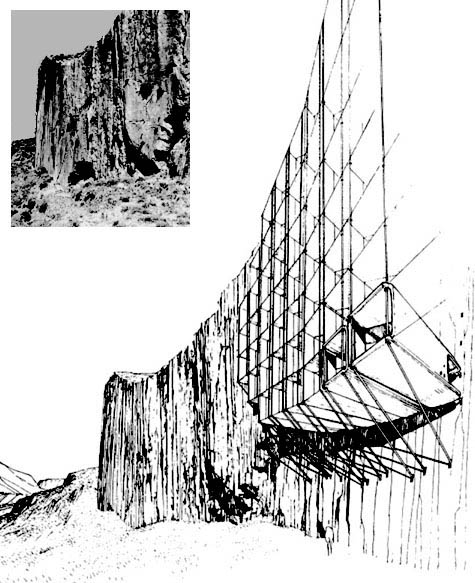 [Image: The Hanging Hotel, strung onto a cliffside like a musical instrument, by Takis Zenetos].
[Image: The Hanging Hotel, strung onto a cliffside like a musical instrument, by Takis Zenetos]. [Image: The Cable City of Takis Zenetos].
[Image: The Cable City of Takis Zenetos]. [Image: The Cable City of Takis Zenetos; the
[Image: The Cable City of Takis Zenetos; the 

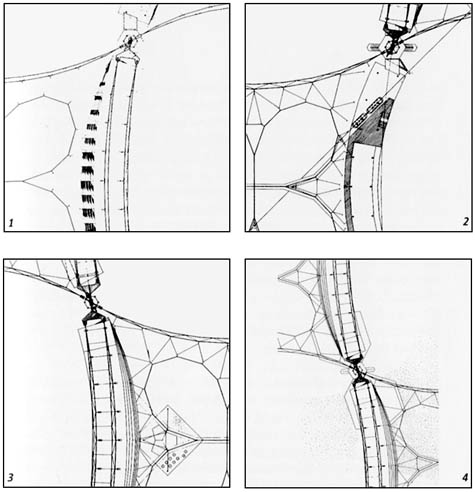
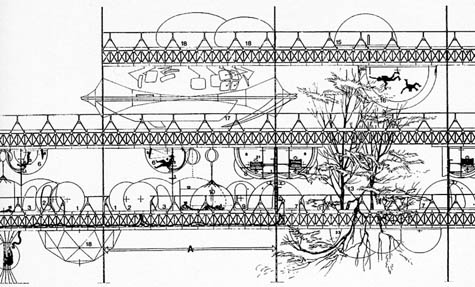 [Images: The Cable City of Takis Zenetos].
[Images: The Cable City of Takis Zenetos].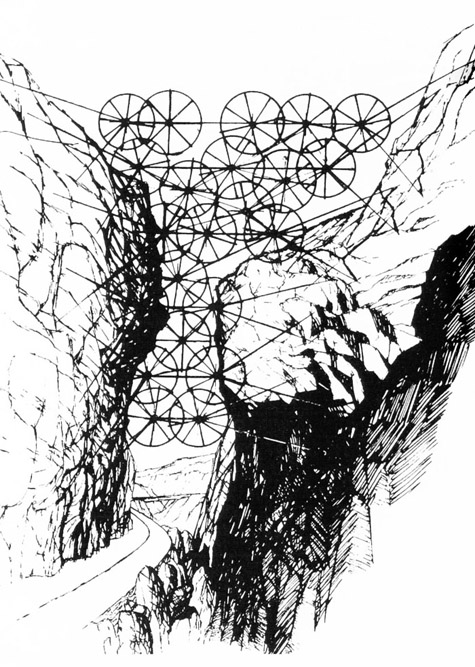 [Images: A turbined gorge by Takis Zenetos].
[Images: A turbined gorge by Takis Zenetos].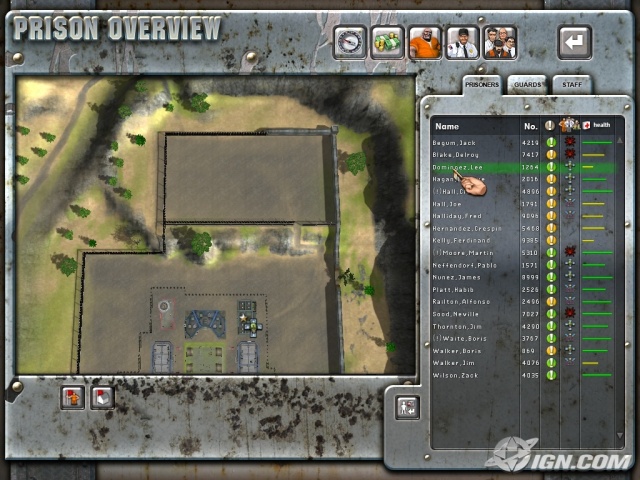 [Image: From Prison Tycoon 4: SuperMax. Image via
[Image: From Prison Tycoon 4: SuperMax. Image via 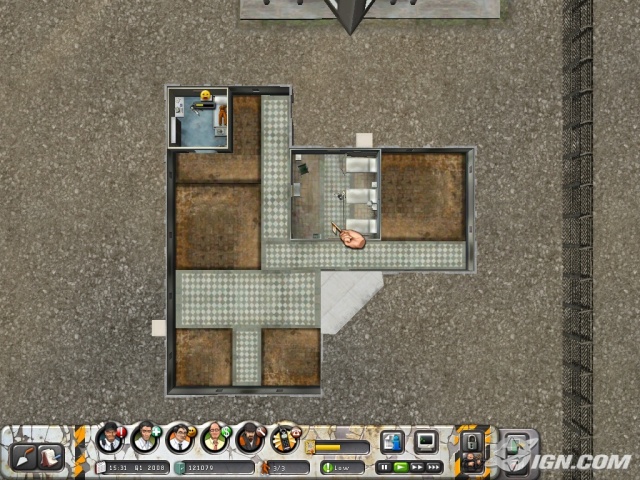
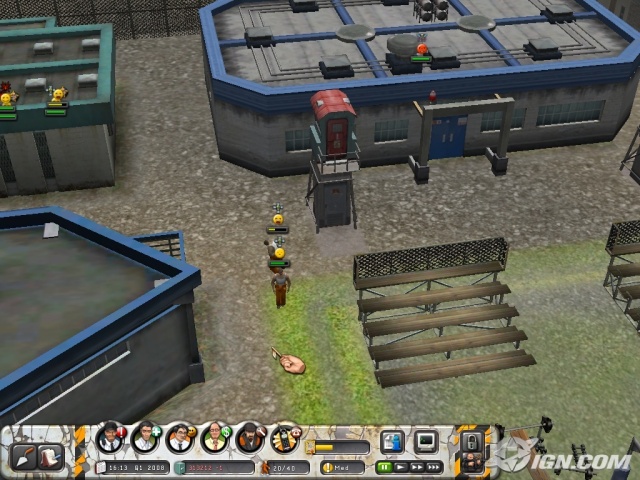
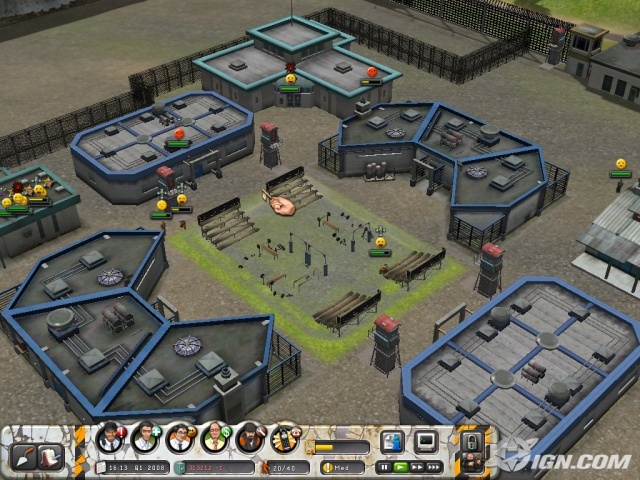
 [Images: From Prison Tycoon 4: SuperMax. All images via
[Images: From Prison Tycoon 4: SuperMax. All images via 
 [Images: From Prison Tycoon 4: SuperMax. Images via
[Images: From Prison Tycoon 4: SuperMax. Images via 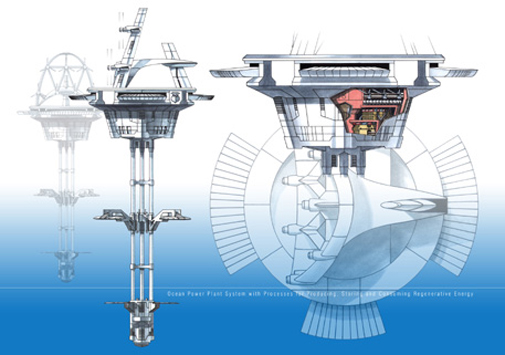 [Image: Offshore energy islands, via
[Image: Offshore energy islands, via